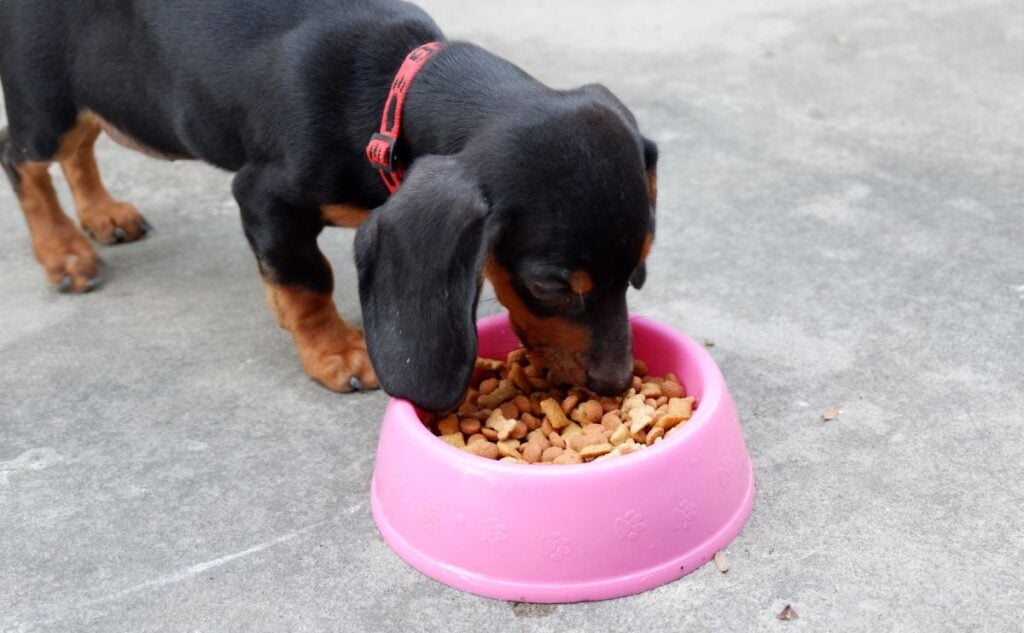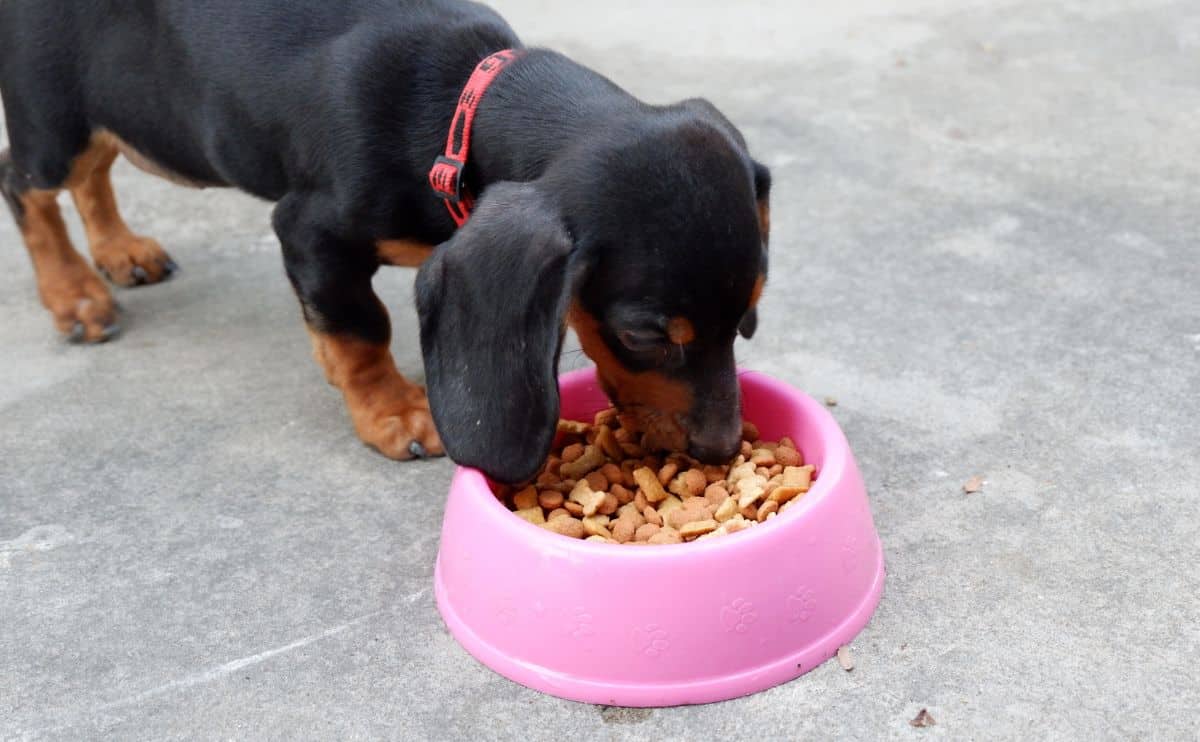If you’re welcoming a Dachshund puppy or aiming to optimize your adult Dachshund’s diet, understanding their nutritional needs is key. These compact, energetic dogs require tailored feeding to support growth, energy, and long-term health. With two main sizes—standard and miniature—this guide covers feeding amounts, food types, essential nutrients, and tips to keep your Dachshund thriving.

Dachshund Feeding Chart By Age & Weight
| Age | Puppy Weight (lbs) | Type Of Food | Cups Per Day | Meals Per Day |
|---|---|---|---|---|
| 0 – 4 weeks | 1/3 – 2 | Mothers’ milk | n/a | Unlimited |
| 4 – 8 weeks | 1 – 4 | Mothers’ milk & puppy mush | n/a | 4 – 6 |
| 8 weeks – 6 months | 4 – 16 | Mothers’ milk & puppy diet | 1/3 – 1 | 3 – 4 |
| 6 – 12 months | 12 – 28 | Puppy diet | 2/3 – 1 1/4 | 3 – 4 |
| 12 – 18 months | 16 – 30 | Puppy or adult diet | 3/4 to 1 1/4 | 2 – 3 |
| 18 – 24 months | 16 – 32 | Adult diet | 3/4 to 1 1/4 | 2 |
Note: This is a general guideline for standard Dachshunds—individual needs may vary.
Dachshund Breed Overview

Dachshunds, with their iconic long bodies and short legs, are lively, intelligent companions originally bred in Germany for badger hunting. Their bold personalities and affectionate nature make them beloved pets. Two official sizes exist: standard (16-32 lbs, 8-9 inches tall) and miniature (≤11 lbs, 5-6 inches tall). Some fall into an unofficial "tweenie" size between the two.
These active dogs thrive on mental and physical stimulation. Proper nutrition, exercise, and training are vital to their health, helping prevent issues like obesity—a risk factor for spinal problems due to their long backs.
Feeding A Dachshund Puppy: Age-Specific Guidelines

Puppy nutrition evolves with growth. Early stages rely on mother’s milk, transitioning to solid food as they mature. Always adjust portions based on activity, health, and weight.
0 – 4 Weeks
Newborns nurse exclusively, getting all nutrients from their mother. Monitor health; consult a vet if milk supply is insufficient.
4 – 8 Weeks
Weaning begins. Introduce puppy mush (softened kibble + milk formula) in 4-6 small meals daily. Watch for teething and increased hunger as signs of readiness.
8 Weeks – 6 Months
Transition to high-quality puppy food. Feed 3-4 meals daily to support rapid growth and energy needs.
6 – 12 Months
Gradually switch to adult food over 7-10 days. Continue 3-4 meals to maintain energy levels.
12 – 24 Months
Adult diet phase. Reduce to 2 meals daily, adjusting portions based on weight and activity. Use food packaging guidelines as a starting point.
Adult Vs Puppy Food: Key Differences

Puppy food is formulated for growth, while adult food balances maintenance. Key differences include:
- Calories: Higher in puppy food to fuel growth.
- Protein: More for muscle development.
- Fats: Richer in DHA for brain/eye health.
- Vitamins/Minerals: Extra calcium/phosphorus for bones.
Overfeeding puppy food to adults risks obesity; transition by 18 months.
6 Puppy Food Types
Choose based on your pup’s needs, budget, and preferences. All should meet AAFCO nutritional standards.
1. Dry Food (Kibble)

Convenient, affordable, and dental-friendly. Opt for high-quality brands with named proteins.
2. Wet Food (Canned)

Moist, palatable, and protein-rich. Mix with kibble for variety but note higher cost.
3. Fresh (Human-Grade)

Premium, minimally processed. Uses human-grade ingredients but requires refrigeration.
4. Raw (BARF)

Biologically appropriate, but requires careful balancing. Consider pre-made raw blends for safety.
5. Vegan Diet

Plant-based, but vets often caution against it for puppies due to nutrient gaps.
6. Home-Cooked

Customizable but time-consuming. Work with a vet to ensure balanced nutrition.
Why High-Quality Food Matters
Premium food supports immunity, digestion, and longevity. Avoid low-quality ingredients like artificial preservatives, colors, and unnamed meats. Look for clear, nutritious labels.
Essential Nutrients For Dachshund Puppies

- Protein: Builds muscles and supports immunity.
- Fats: Provides energy; DHA aids brain development.
- Carbs: Sustains energy (choose whole grains).
- Vitamins/Minerals: Support cell function and bones.
- Water: Critical for hydration (1 oz per lb daily).
Ideal Weight & Weight Management

Standard Dachshunds: 16-32 lbs; miniatures: ≤11 lbs. Obesity worsens spinal risks. Maintain weight by:
- Following food guidelines.
- Measuring portions.
- Limiting treats (≤10% of daily calories).
- Ensuring daily exercise.
Frequently Asked Questions
What Should I Feed My Dachshund Puppy?
High-quality small-breed puppy food meeting AAFCO standards, rich in protein and fats.
How Much Should I Feed My Dachshund Puppy?
Follow package guidelines, adjusting for age, weight, and activity. Use measuring cups.
How Do I Know If My Puppy Is Eating Enough?
Monitor steady growth and energy. Consult a vet if weight gain/loss is excessive.
Standard Vs Miniature Feeding Amounts
Adults: Standards need 3/4-1 1/4 cups daily (2 meals); miniatures need 1/4-1/2 cups. Adjust for activity and age.
Other Dachshund Essentials
Beyond food, ensure you have a crate, bed, toys, and pet insurance. Our puppy checklist covers all basics to keep your Dachshund happy and healthy.

